While Laos is often synonymous with Vientiane, Vang Vieng, and Luang Prabang, venturing north to Phongsaly offers a truly off-the-beaten-path adventure. In fact, parts of the journey involve navigating areas where roads are minimal. This remote northern region, bordering China and Vietnam’s Sapa, is a haven for diverse ethnic hill tribes. Its relative obscurity, coupled with the promise of breathtaking stargazing, drew me to explore its hidden treasures. For those seeking unique things to do in Phongsaly, this journey promises an unforgettable experience.
Three-quarter into the way, the minivan tyres encountered some problems, and we had to stop at a village for repairs. So much for being faster… this delay costs me more than an hour. The village is so sparse there’s nothing much to see too.
Traditionally, for the first leg of the journey from Luang Prabang, you can take a 6-hour passenger boat up the Nam Ou river to the village of Nong Khiaw. The views along this stretch of the Nam Ou is reputedly one of the best. However, ever since a road has been built from Luang Prabang to Nong Khiaw, most opt to travel this way since its only about 3 hours. The frequency of the slow passenger boats plying the route have thus been reduced to almost none. So my journey started with a minivan ride to Nong Khiaw.
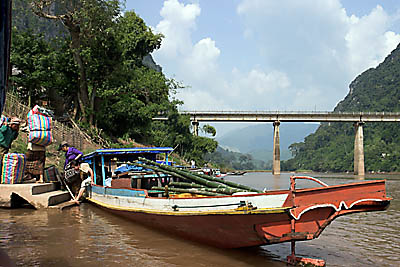 Finally arrived at Nong Khiaw, and enquired about the availability of boat service to Muang Khua, my next stop. Apparently, it is based on demand, and there isn’t any, so one of the locals suggested going over to Muang Ngoi, a small village an hours boat ride away, and check there. The guidebook had good reviews of it so I decided to take the short boat trip up.
Finally arrived at Nong Khiaw, and enquired about the availability of boat service to Muang Khua, my next stop. Apparently, it is based on demand, and there isn’t any, so one of the locals suggested going over to Muang Ngoi, a small village an hours boat ride away, and check there. The guidebook had good reviews of it so I decided to take the short boat trip up.
The slow boats are not just for passengers, they carry all manner of goods as well. A number of the small villages along the Nam Ou, including Muang Ngoi, are only accessible by river and so plenty of things are transported by boat. People with long legs (like me) will be a little uncomfortable in these boats. Luckily, its only an hour. I pushed back the thought of the 5-hour boat ride to Muang Khua…
Muang Ngoi is really an idyllic village, set on the shores of Nam Ou.
The whole ambience and atmosphere is relaxing and really a wonderful place to chill out. The bamboo mat huts are delightful!
My room is certainly basic but it afforded me one of the best sleeps I had in a long time. Until of course, about 4.30am to 5am, when the incessant crowing of the resident roosters drive me out of bed. Still, not bad considering it costs me US$1.50.
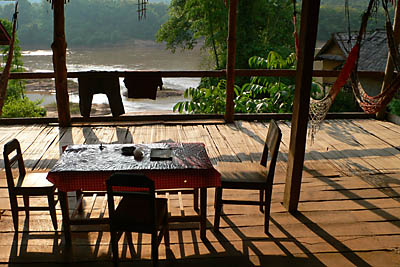
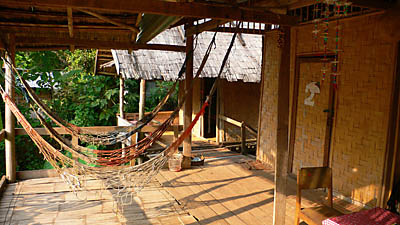 The first word I think of when in Muang Ngoi is ‘Kampung’. From the huts, to the single lane “street”, the chickens digging around, to the dogs baying about. This turns out to be one of the highlights of the journey! The fact that it is only accessible by boat makes it somewhat more exotic as well!
The first word I think of when in Muang Ngoi is ‘Kampung’. From the huts, to the single lane “street”, the chickens digging around, to the dogs baying about. This turns out to be one of the highlights of the journey! The fact that it is only accessible by boat makes it somewhat more exotic as well!
The next day, I enquired again on boats going up to Muang Khua. Again, there was no boat. One of the boatmen suggested chartering the whole boat for US$40, which was way beyond budget! So I had to wait again, and sat around the pier reading my book. It was till noon before another boat arrived and the boat was indeed going upriver! However, it was not going all the way up to Muang Khua, so I had to negotiate a price, from its initial requested price of US$20 to US$12. At least I can continue my journey!
The boat ride was close to 5 hours but parts of it was interesting enough to tide me through. The boat is like a bus that transports locals to the various small villages at Nam Ou. There was no real stopping point, but the villagers know exactly where to tell the boatman to stop. And there would be some people at the shore to help unload whatever goods they brought back. And the children of Nam Ou – carefree as can be; it reminded me of a time long ago. They probably had very little contact with the outside world, especially with the scarcity of these passenger boats! While I may look like one of the locals, the children were tickled to see my sunglasses and their reflection!
Muang Khua is a town by the Nam Ou that is more well-known as the border town after crossing from Dien Bien Phu, Vietnam. By all accounts, the route and border crossing at Tay Trang is chaotic and you’re likely to pay more than usual to get transported across either way. In fact, the Nam Ou guesthouse which I stayed for the night received such a group who have just crossed over from Vietnam. The town itself seemed busy and not lacking in commerce, though its buildings are all old and in need of repair. Since I arrived late in the evening, I didn’t get to see much, and planned on moving on early next morning to catch the boat to Hat Sa, the next port village before reaching Phongsaly by road.
It was the same old story the next morning, with no demand for boats up to Hat Sa. Or rather, there was no slow boats going upriver. Apparently, the locals seemed to be a hurry somewhat, and all prefer to travel up by fast boats. These fast boats, or speedboats, were described by my guidebook, as well as other guidebooks, as dangerous affairs. All generally advised against going in one, especially with no life vest, no shelter, and even smaller sitting space!! In my eagerness to reach Phongsaly however, my judgement was somewhat impaired, and so I paid US$10 to put my life in danger. It was an exhilarating ride no doubt and my journey was cut down from 4+hours to 2hours.
Hat Sa is a really small village with (shop)houses leading up from the river embankment. There is only one daily bus from Hat Sa to Phongsaly, and since I took the fast boat, I arrived early. The bus leaves in the afternoon, so I settled around to observe the people/children. Being river folks, it seems that much of their leisure is centred on the river.
It was a terrible road from Hat Sa to Phongsaly. As the bus rumbled into town, I saw the potential of the place. But that was all I saw, as fate has it, the weather decided to turn nasty from that day onwards.
Phongsaly, through its histories, had heavy influence from China. In fact, there was an old part of town that seemed reminiscent of old Chinese towns. Today, most of the businesses here seem to be owned by Chinese. The guesthouses, hotels, shops, architecture, products – it all shows. The locals are mainly the Phu Noi, one of the Laos ethnic minorities and on occasions, visiting Akhas from neighbouring villages. On the outskirts of town though, it’s a step back in time, with old grannies feeding the chickens and watching life goes by.
I decided to find a local guide and arrange a short trekking trip into the forest and stay in an Akha village. This was easily done and as dusk came, the drizzling day turned to gloomy night. I quote from my guidebook “On clear nights, as soon as the lights go out, the view of the heavens are unparalleled. The crisp air seems to amplify the stella glow and the Milky Way is splashed across the sky like a giant luminecent cloud”. Alas, it was far from being a clear night, and the giant cloud that blanketed the sky is hardly luminescent, but dampening.
The trek started early morning, but with no sunrise in sight. It rained in the night, and the ground showed. Nevertheless, we went ahead, the starting easy enough. We passed by a Phu Noi village, and after that, ventured into the mountains proper.
The slopes were steeper than I thought, and coupled with the wet muddy ground, it was tough going. The trek goes downhill towards the river and so I slipped many times. The air was humid, and I was drenched with perspiration in no time. To complete my misery, the ground was mired with leeches that were relentless in clinging onto me. By the time I reached the river and the midpoint for lunch, I was exhausted. Unfortunately, my knee was jolted on one of my slips, and it was beginning to feel sore. Worse, the second half of the trek was uphill and longer than the first! So it was with great reluctance that I had to abandon my trek and return to town. Of course, going back the way I came, I struggled uphill as well. As I got within an hour of reaching town, the sky poured out its sorrow on me, amplifying mine. I reached town about 7pm, dark, drenched, shivering and miserable.
The 3 days and nights at Phongsaly was quite a disappointment. The days were drizzling and the nights were cloudy without a whiff of the stars in sight. I didn’t get to see the Akha village. And the thought of the journey out of Phongsaly, down to Oudomxay was equally demoralising. The guidebook, and some online forums have indicated that the 10-hour journey was braved on a sawngthaew, a mini pickup of sorts. Nobody ever wanted to do it twice.
So, the next morning, with a heavy heart, I limped to catch my transportation. For the first time in the last three days, I felt delighted! Apparently, the route is now serviced by a bus – a proper bus! The road conditions, however, remains as reported in the guidebook and online. Dismal. That didn’t stop me from being in a comatose state for most of the 10 hours as I leave Phongsaly behind.
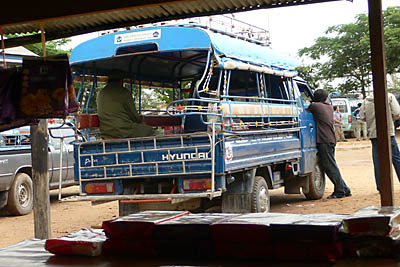 A Sawnthaew
A Sawnthaew
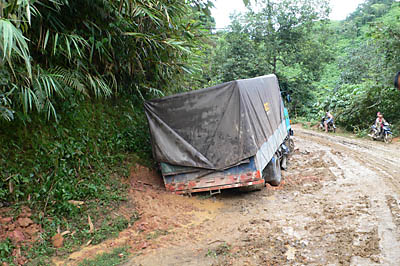 Sticky situation
Sticky situation
Contributed by Roving Light.






